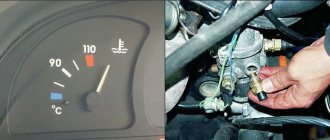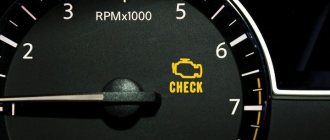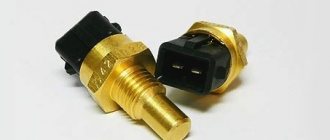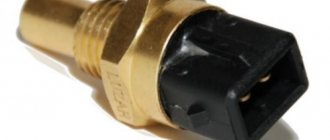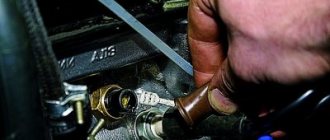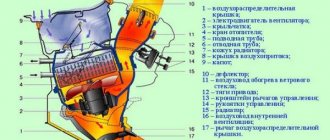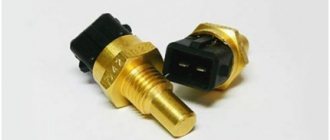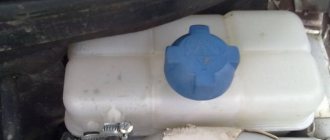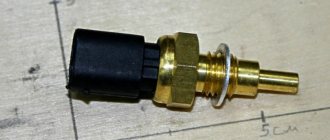Share:
Engine coolant temperature sensor 405, 406, 409, 4213, 4216 (DTOZH) is the topic of this article. Here are the technical specifications, electrical diagram for connecting the engine coolant temperature sensor 405, 406, 409, 4213, 4216. Experimental data on the resistance of the coolant temperature sensor model 19.3828 are provided separately. The location on the engine where the DTOZH is located is indicated. Engine malfunctions caused by a breakdown of the DTOZh and methods for their determination are described. The replacement of engine coolant temperature sensor 405, 406, 409, 4213, 4216 is described.
- 8.1 — Checking the coolant temperature sensor using the self-diagnosis function;
- Video - replacing the coolant temperature sensor (DTOZH) on the 405, 406, 409, 4213, 4216 engine:
Purpose and principle of operation of the engine temperature sensor
The device is designed to measure the temperature of engine coolant 405, 406, 409, 4213, 4216 at different times of the year, under different weather conditions and send its data, converting it into a voltage unit, to the ECU. Thanks to DTOZH, the car’s computer starts the engine, keeps it in working condition, and turns on the fan for cooling. The information received from the coolant temperature sensor allows the ECU to determine the engine temperature and, using the program, calculate the required amount of fuel required to be supplied by the injector to the cylinders.
There are several types of engine coolant temperature sensors according to their purpose:
- DTOZH for supplying information to the temperature indicator on the instrument readout.
- Coolant temperature sensor that supplies data to the engine ECU.
- Device for emergency overheating of engine coolant. It sends its data to the red control light located on the engine temperature gauge.
- The coolant temperature sensor ensures the operation of the engine cooling fan.
- An air temperature sensor that supplies the computer with information about the temperature in the receiver of the injection engine.
The coolant temperature sensor is essentially a semiconductor device - a thermistor. It is capable of changing its internal electrical resistance when its heating temperature changes. These engine temperature sensors are made from materials with a high temperature coefficient. It can be negative, NTC thermistors, and positive, PTC thermistors or posistors. For DTOZh with a negative temperature coefficient (NTC thermistors), as the temperature rises, the internal electrical resistance decreases. This type of NTC thermistors includes coolant temperature sensors model DT-215 and its analogs 234.3828, 421.3828. PTC thermistors or posistors, on the contrary, increase their internal electrical resistance as the temperature rises. A representative of this group of PTC thermistors is the engine temperature sensor model 19.3828 and its analogues 42.3828, DT-226.
The device is a semiconductor zener diode, powered by a constant voltage (5 volts) from the ECU.
The output voltage of the device changes with the temperature of the antifreeze. As the heat of the antifreeze increases, the output “U” of the device changes.
The principle of operation of the engine coolant temperature sensor (DTOZH) 405, 406, 409, 4213, 4216 is the ability to change the resistance of the sensing element depending on changes in the temperature of the surrounding coolant. And naturally, this changes the output voltage coming from the device to the computer, which controls the operation of the motor. Using this data, the ECU calculates parameters for the operation of the injectors. Based on this, this is a very important device in the engine control system, especially during its startup.
Video - review of engine coolant temperature sensor 405, 406, 409, 4213, 4216:
Healthy ! Crankshaft sensor
Healthy ! Crankshaft sensor
Original solution
What if you don’t go shopping and waste time and money, but buy a donor car for disassembly? For example, Volga 3102 produced in 1999-2004. We don’t need fairly well-maintained cars in garage storage because of the high price; it’s better to focus on the remodeling budget, choosing the available options. You can still buy a donor car from the original owners at a reasonable price
Important! Since we are interested in the electrical part, it is quite acceptable to purchase a car with defects. And although we will not take everything, modernize
Engine coolant temperature sensor 405, 406, 409, 4213, 4216
This section contains complete information about the DTOZ of power units 405, 406, 409, 4213, 4216, located on UAZ and Gazelle vehicles.
Engine coolant temperature sensors have one or more output terminals:
- DTOZH device with one terminal:
- Device with two terminals:
- Temperature sensor with three leads:
- Engine Coolant Temperature Sensor with 4 Terminals:
The engine coolant temperature sensor 405, 406, 409, 4213, 4216 consists of a metal housing containing semiconductor temperature-sensitive elements. At the lower tip of the device body, inside at the ends of the metal rods, there is a thermistor. At the top of the device there is a plastic connection block with two output terminals in the form of flat plates. On the metal part of the device body there is a hexagonal projection for a 19 key. Under the hexagon there is a socket for a gasket. Below the gasket socket there is a thread M 12 x 1.5.
Healthy ! Camshaft sensor
Electrical diagram connecting the engine coolant temperature sensor 409, 405, 406
Healthy ! Camshaft sensor
DTOZH connector
The sensor is connected to the electrical circuit using a two-pin connector, which is protected by a frame spring that prevents it from being disconnected from shaking and vibration.
What is needed for remodeling
If you modernize it, it will be completely, including the injector, and for this you should take a closer look at the Digitronic gas-cylinder equipment. This HBO is praised by many, and it can be installed on Gazelle.
Many people know about the economical consumption of a car with LPG.
But there is one significant nuance - to equip a car with Digitronic, you need an injection engine, “tuned” to Euro-2 toxicity standards.
And then, modifications for the injector will not end there, because the following components and parts will be needed:
- The injection wiring on the Gazelle - 406 engine does not have it, not to mention the control unit;
- Intake system, including the manifold itself with the injector ramp, throttle position sensor, throttle pipe, idle air control and additional air regulator, connecting pipes and pipes;
In the photo - a diagram of the electrical equipment of the gasoline version of the ZMZ 406
Note! Wiring for Gazelle 406 is also available at disassembly sites. But its performance and reliability cannot be guaranteed.
- Injection camshafts. This point is controversial, since it is quite possible to leave carburetors on the car. The main difference between them is the lifting height, which affects the power;
- Electric fuel pump together with a fine fuel filter;
- Mass air flow sensor with connecting pipes;
- Air filter housing with bracket;
- Electric fan (but not required).
Where is the coolant temperature sensor located?
Here is information about the location of the DTOZH on engines 405, 406, 409, 4213, 4216 of UAZ and Gazelle vehicles. The location of the device is illustrated with photographs.
On different engines, the DTOZH is attached in different places:
- On 405, 406, 409 engines it is installed on the thermostat housing.
Mounting location of the coolant temperature sensor on the UMZ 4213, 4216 engine:
The device is screwed into a hole with an M12x1.5 thread.
Theory
The main ambush for the client and the diagnostician lies in the following. On engines E-0, E-2, sensors come from the factory with a “square” connector, on E-3, E-4 with an oval connector. But that is not all. On E-0 and E-2, these sensors are also non-interchangeable and differ according to the type of ECU. But most importantly, DTOZH ZMZ 406, 405, 409 should be from Russian factories or brand manufacturers (Bosch). Relatively high-quality products are produced by two Kaluga and Autotrade. Sensors of glamorous pink color from Arzamas are “not that”. Sensors of all colors of the rainbow from the Middle Kingdom, “not at all.” What should be included according to the factory documentation:
- EURO-0, ECU MIKAS7.1 – DTOZH 19.3828, 42.3828 or 40.5226. The operating principle is a thermal diode. The sensor housing is black.
- EURO-2, ECU MIKAS-11VS8, SOATE – DTOZH 40.5215. Thermistor. The sensor housing is gray.
- EURO-3, EURO-4. Catalog number 40904.3828000. DTOZH 234.3828. Oval connector.
Engine coolant temperature sensor malfunctions
This section lists possible engine malfunctions caused by a breakdown of the DTOZH.
| Engine temperature sensor faults 409 | Remedies |
| 1. Increased speed of free rotation of the heated motor. The indicator lights up when the engine is running. Checking the ECU notes the failure code 21 or 22. | Check the integrity of lines 45 and 30D of the device |
| 2. Low or high level of the DTOZh signal. The check lamp lights up when the electrical power is connected. The ECU diagnostic itself notes fault codes 17 or 18. | Check the integrity of lines 44 and 30V of the air temperature device |
| 3. When the engine has cooled down, it will not start (it doesn’t matter if it starts). The check light does not light (there is no system failure) | The device is poorly configured. Check the setting and change the meter |
| 4. When starting the engine, the spark plugs are heavily flooded. The engine does not start. The DTOZH shows the engine temperature lower than the air temperature. | Replace temperature sensor |
| 5. When starting the engine, the spark plugs are dry. The engine doesn't catch. DTOZH shows a temperature higher than the air temperature. | Incorrect calibration of the coolant temperature sensor. Replace the device. |
Healthy ! Coolant temperature gauge sensor
Gazelle
Model ZMZ 40524.10 is a gazelle carburetor known to everyone. The car brand “Gazelle” is one of the most popular and affordable trucks in Russia, which were originally intended for transporting not very large loads. Due to the huge number of such machines, we will consider several nuances of different gazelle systems. For example, a microprocessor ignition system, which is installed on the 406 model.
If the driver claims that his car makes some popping noises, jerking noises and loses its power. In this case, the power system, engine and ignition system should be checked. We checked the carburetor with a gas analyzer not during the operation of the 1st and 2nd chambers, cutoff, enrichment and during idling and did not find any violations. Next they check the engine. When checking the compression, no problems were identified, but the next time deviations from the norm were detected. It was concluded that the jerks and pops that the driver did not like were due to the jumping of the teeth of the upper chain.
Carburetor ZMZ 406 series
What to do if a gazelle loses power?
From the very beginning, you need to check how the diagnostic circuit and the on-board diagnostic system function, because when the travel image mode is activated, a malfunction code of 12 should be obtained. To read the code, the 10th and 12th contacts of the diagnostic block must be closed.
Using a diagnostic toaster, engine sensor parameters are measured and then compared with typical values for average engines. The most common reason for a decrease in car power is contamination of the tube that connects the intake manifold and the pressure sensor.
Gazelle ignition system
The microprocessor ignition system ignites the working fluid in the cylinders and sets the required vehicle ignition timing for all engine modes. The ignition system performs the function of regulating the operation of the forced idle economizer.
Thanks to the ignition system, engine operation becomes more economical, compliance with all exhaust gas toxicity standards is monitored, detonation is eliminated and the vehicle's power is increased. If we compare the classic system with this one, then this ignition system is much more reliable and durable. Here only the spark plugs can wear out.
How does diagnostic mode work?
When the ignition system is turned on, the indicator light begins to light. At that very moment, the diagnostic system begins to work. If the system is working properly, the light stops lighting, but otherwise it continues to light. That is, an extinguished warning light indicates that the ignition system is absolutely working.
Carburetor ZMZ 406 series
Why does the 406 engine sometimes not start during a freeze?
The most common reasons why the 406 engine does not start:
- Poor quality oil;
- The battery is not powerful enough, which prevents the engine from starting;
- Faulty starter;
- Misregulated ignition system;
- Poor quality gasoline;
- Failure to supply gasoline.
How to adjust the carburetor?
- Disconnect the choke actuator cord;
- Remove the air filter and carburetor cap;
- Check the level of the float chamber, it should be below 3 centimeters from the edges;
- Remove the plug from the float rod;
- Make sure the valve seal ring is tight;
- Install the carburetor top;
- Install the choke cable and air filter;
- Screw in the idle speed adjustment screw all the way, unscrewing it five turns. Carry out the same actions with the quality screw, but unscrew it three turns;
- Start the power unit;
- Let it heat up to 90⁰;
- By rotating the operational adjustment screw, select the crankshaft speed, about 700 rpm;
- Press the accelerator pedal and release quickly. If the engine stalls, increase the frequency;
- Stop by a car dealership and adjust the CO and CH of the engine.
Resistance of coolant temperature sensor 19.3828 and its analogues
| Resistance table of temperature sensors for engines 405, 406, 409 | |
| Temperature, С | Sensor resistance, kOhm |
| 100 | 34 |
| 90 | 33,4 |
| 80 | 32,8 |
| 70 | 32,2 |
| 60 | 31,6 |
| 50 | 31 |
| 45 | 30.8 |
| 40 | 30.6 |
| 35 | 30.3 |
| 25 | 29.9 |
| 20 | 29.6 |
| 15 | 29,5 |
| 13 | 29.4 |
If the data differs significantly, then the DTOZH has failed and needs to be replaced. An experiment to test the resistance of the coolant temperature sensor can be viewed: Here
Detonation
Detonation is an unauthorized ignition of the air-fuel mixture in the cylinders of the power unit. If the engine operates in this mode for a long time, this can lead to high vibrations, as well as high loads on the internal combustion engine components. Ultimately, this contributes to more accelerated wear of engine parts, in particular, we are talking about the pistons of the unit, cylinder head gasket, rings, etc. The engine knock sensor is mounted on the right side of the BC; it itself is a piezoelectric regulator.
The main components of the device are a quartz piezo component, as well as an inertial mass. When an internal combustion engine is running, many of its components vibrate. Due to detonation, higher vibrations are formed in the system, as a result of which the voltage amplitudes of electrical pulses in the power unit sharply increase. The impulses themselves are transmitted to the ECU.
In accordance with the signals received from the controller, the ECU adjusts the ignition timing until the detonation stops. If the element itself or one of the electrical circuits breaks down, the ECU will notify the car owner about this via a light indicator on the dashboard.
Replacing engine coolant temperature sensor 405, 406, 409
This section describes in great detail the sequence of replacing the DTOZH. Each operation is illustrated with a photograph.
- Loosen the nut with a 13mm wrench and remove the minus terminal from the battery
- Remove the terminal block from the temperature meter. On the ZMZ 409 engine, to do this, you need to press the locking spring and remove the terminal block.
- Before unscrewing the old coolant temperature sensor, you need to prepare a replacement. Place it nearby so that you can take it quickly without searching.
- Using a 19mm wrench, unscrew the old sensor:
- The engine coolant temperature sensor is being replaced with a new one.
- To do this, after removing the old device from the socket, immediately insert a new one, prepared in advance. We tighten it with a 19 key until it stops.
- We put the terminal block on the device:
- We connect the minus terminal of the electrical network to the battery:
Video - replacing the coolant temperature sensor (DTOZH) on the 405, 406, 409, 4213, 4216 engine:
How to check the oil pressure sensor
If you have any suspicions about the performance of the pressure sensor, do not be lazy to check it. This can be done both at a service station and at home. But in the latter case, you will need to purchase a special pressure gauge. It costs about 300 rubles, but such a thing will be useful in the future. In addition to this, you will also need a slotted screwdriver, a 22 mm wrench and electrical tape.
To check the functionality of the sensor, you will need a special pressure gauge
Check procedure:
- We lift the hood and find the fitting with the sensors.
- Using a slotted screwdriver, unscrew the bolt securing the power wire terminal to the emergency oil pressure sensor. We disconnect the wire and insulate its end (so as not to cause a short circuit during testing).
- Using a 22mm wrench, unscrew the emergency pressure sensor.
- In its place we screw in the pressure gauge fitting.
- Turn on the ignition, start the engine, wait until it warms up to operating temperature.
- We compare the readings of the pressure gauge and the indicator.
If they differ significantly, we change the sensor. To check the pressure, you need to screw the pressure gauge fitting into the mounting socket of the emergency oil pressure sensor
Video: checking the oil pressure in the system
Other faults
However, a deviation in the pressure value can be associated with both wiring faults and problems with the indicator itself. Don’t be lazy to carry out additional diagnostics. Her order is as follows.
Turn on the ignition. The pointer arrow should deviate to the right and then return to its original position. If the arrow does not deviate, use a slotted screwdriver to unscrew the screw securing the sensor power wire, disconnect it and touch ground. The arrow has deviated - there is a short circuit in the sensor's power supply wiring. If not, the problem should be looked for in the pressure indicator.
Crankshaft
The crankshaft sensor or DPKV is an inductive type device; it is mounted in the front of the engine, on the right side, at the bottom. DPKV works together with a synchronization shaft equipped with 60 teeth, 2 of which are pre-removed. These two teeth are missing for a reason - their position corresponds to the top dead center of 1 or 4 cylinders of the internal combustion engine. The purpose of the DPKV is to synchronize the control phases of the electrical mechanisms of the system with the timing phases. The regulator marks each crankshaft revolution, thanks to which the computer calculates the injection phases, as well as the ignition timing.
The optimal backlash between the end part of the controller, as well as the tooth of the synchronization disk, is about 0.5-1.2 mm. The element itself is powered by the control unit and is connected to it by wire using a three-pin connector.
Sorry, there are no surveys available at this time.
Technical characteristics of DTOZH
This section provides comprehensive technical characteristics of the coolant temperature sensor 19.3828 for engines 405, 406, 409, 4213, 4216, UAZ and Gazelle cars.
- Power supply 5-12 V
- I = 0.5-5.0 Ma
- Street heat spectrum -40 – +125 0C
- R = 24-27 kOhm
- It has a direct ratio of the exhaust U to the heat of the propulsion
- Its sensitivity is 10mV/0C
- Calibration data: -600C:2.13B – calibration violation, line failure
- -400C:2.33B
- -300C:2.43B – frozen engine
- -200C:2.53B
- 00C:2.73B
- +200C:2.93B – cooled engine
- +400C:3.13B
- +700C:3.43B – heated engine
- +800C:3.53B
- +900C:3.63B
- +1050C:3.83B – overheated propulsion
- +1250C:3.93B – calibration damage, communication failure
